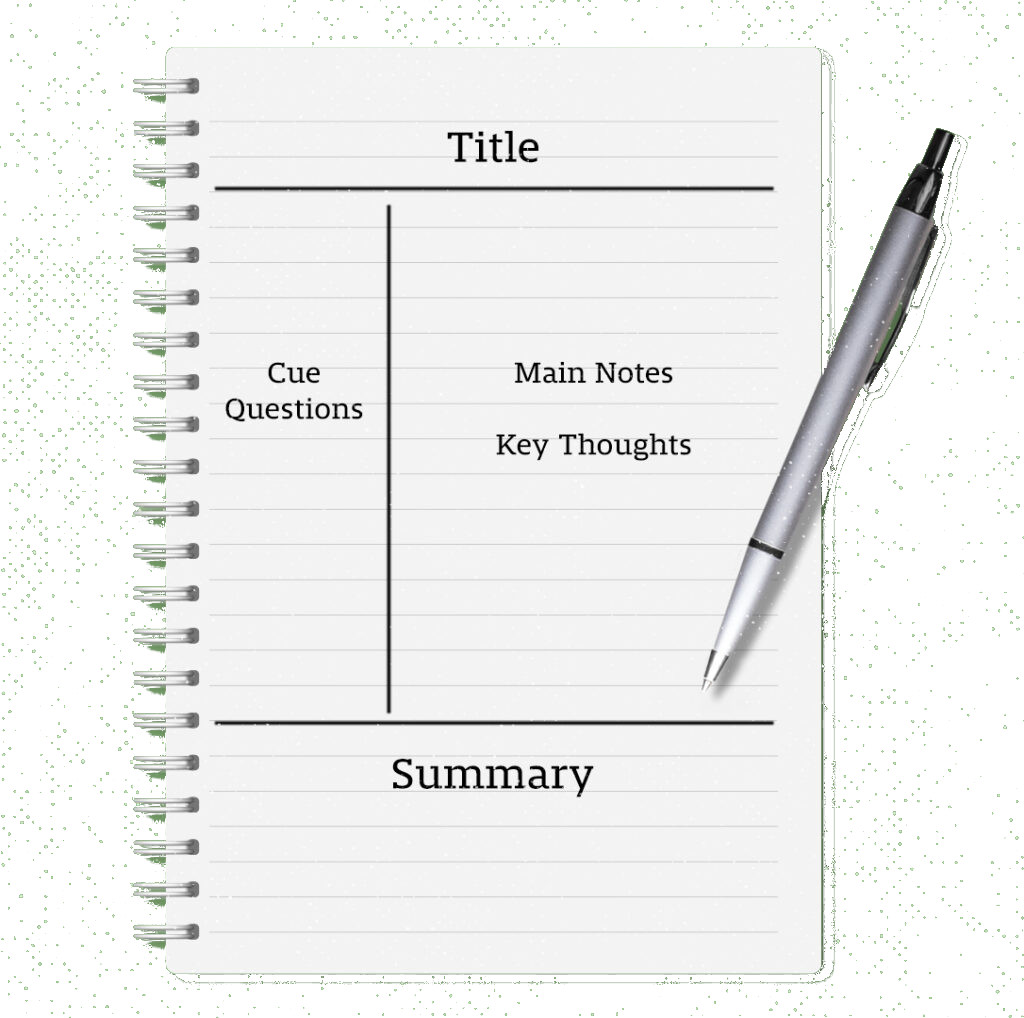Cornell Note Taking: The Secret to Retaining Information and Boosting Grades

Cornell Note-Taking is a widely recognised and effective method for capturing and organising information during lectures, presentations, and readings. It was developed in the 1940s by Walter Pauk, an education professor at Cornell University. The method is designed to help students actively engage with the material, improve their understanding and retention of information, and ultimately enhance their academic success.
Note-taking is a crucial skill for students to develop as it allows them to capture important information, review and study effectively, and reinforce their learning. By taking notes, students are able to actively listen and engage with the material, rather than passively absorbing information. This active involvement helps to improve comprehension and retention of the material, making it easier to recall and apply the information later on.
The Science Behind Cornell Note-Taking
To understand why Cornell Note-Taking is so effective, it is important to understand how the brain processes and retains information. The brain has a limited capacity for attention and memory, so it is important to optimize the way information is presented and encoded in order to maximise retention.
When we encounter new information, it first enters our sensory memory, which has a very limited capacity and duration. From there, the information may be transferred to our short-term memory, where it can be held for a brief period of time. However, in order for information to be retained in our long-term memory, it needs to be actively processed and encoded.
Cornell Note-Taking aligns with the brain’s natural processes by encouraging active engagement with the material. By actively listening, summarizing, and reflecting on the information, students are able to process and encode the information more effectively. This helps to strengthen the neural connections associated with the material, making it easier to recall and apply the information later on.
How Cornell Note-Taking Helps Retain Information
The Cornell Note-Taking method consists of three main sections: a narrow left-hand column for cues or questions, a wider right-hand column for notes, and a bottom section for summarising the main points. This structure helps students to actively engage with the material, improve their understanding and retention of information, and enhance their overall learning experience.
The first step in the Cornell Note-Taking method is to take notes during the lecture or reading. The right-hand column is used to capture the main ideas, key points, and supporting details. It is important to be selective and concise when taking notes, focusing on the most important information rather than trying to write down everything.
The left-hand column is used to jot down cues or questions that will help trigger recall and retrieval of the information later on. These cues can be in the form of keywords, questions, or prompts that will help jog your memory when reviewing your notes. By actively thinking about and generating these cues, you are engaging with the material on a deeper level and strengthening your understanding and retention of the information.
The bottom section of the Cornell Note-Taking method is used to summarise the main points of the lecture or reading. This summary should be concise and capture the key takeaways from the material. By summarizing the information in your own words, you are further processing and encoding the information, making it easier to recall and apply later on.
The Benefits of Cornell Note-Taking for Students
Cornell Note-Taking offers a range of benefits for students, helping to improve their academic performance, increase their engagement and participation in class, and enhance their critical thinking and analysis skills.
One of the key benefits of Cornell Note-Taking is improved academic performance. By actively engaging with the material and organizing your notes in a structured manner, you are better able to understand and retain the information. This makes it easier to study and review for exams, leading to improved performance on assessments.
In addition to improved academic performance, Cornell Note-Taking also increases engagement and participation in class. When students are actively listening and taking notes, they are more likely to be engaged with the material and participate in class discussions. This active involvement helps to deepen their understanding and retention of the information, as well as foster a more interactive and collaborative learning environment.
Furthermore, Cornell Note-Taking helps to develop critical thinking and analysis skills. By summarizing and reflecting on the material, students are encouraged to think critically about the information, identify key concepts and connections, and analyze the material in a meaningful way. These skills are essential for academic success and can be applied to a wide range of subjects and disciplines.
How to Set Up Cornell Notes
Setting up Cornell Notes is a straightforward process that can be easily adapted to suit your individual preferences and needs. Here is a step-by-step guide to setting up Cornell Notes:
- Divide your paper into three sections: a narrow left-hand column, a wider right-hand column, and a bottom section.
- Label the left-hand column as “Cues” or “Questions”.
- Label the right-hand column as “Notes”.
- Label the bottom section as “Summary”.
- During the lecture or reading, take notes in the right-hand column, focusing on the main ideas, key points, and supporting details.
- As you take notes, jot down cues or questions in the left-hand column that will help trigger recall and retrieval of the information later on.
- After the lecture or reading, summarise the main points in the bottom section using your own words.
Examples of Cornell Notes for different subjects:
– Science: In the left-hand column, you could jot down questions about key concepts or experiments. In the right-hand column, you could take notes on the main ideas, supporting evidence, and conclusions. In the bottom section, you could summarise the key findings or implications of the research.
– History: In the left-hand column, you could jot down cues or prompts about important events, dates, or figures. In the right-hand column, you could take notes on the main ideas, key events, and historical context. In the bottom section, you could summarise the main themes or significance of the historical period.
– Literature: In the left-hand column, you could jot down cues or questions about key themes, characters, or symbols. In the right-hand column, you could take notes on the main ideas, key quotes, and literary devices. In the bottom section, you could summarise the main plot points or analyze the author’s message.
Tips for Effective Cornell Note-Taking
While the Cornell Note Taking method provides a structured framework for capturing and organising information, there are several strategies and tips that can help enhance your note-taking experience:
- Actively listen and engage with the material: Pay attention to the speaker or text, and try to actively process and understand the information. This will help you to identify the main ideas and key points that should be included in your notes.
- Be selective and concise: Focus on capturing the most important information rather than trying to write down everything. Use abbreviations, symbols, and shorthand to save time and space.
- Use headings and subheadings: Organise your notes using headings and subheadings to help structure and categorize the information. This will make it easier to review and study your notes later on.
- Highlight or underline key points: Use highlighting or underlining to draw attention to important information or key concepts. This will make it easier to locate and review the most important information when studying.
- Review and revise your notes regularly: Set aside time to review and revise your notes on a regular basis. This will help reinforce your learning and improve your retention of the material.
- Use visual aids or diagrams: If appropriate, use visual aids or diagrams to help illustrate complex concepts or relationships. This can be especially helpful for visual learners.
- Summarise and reflect on the material: After the lecture or reading, take some time to summarise the main points in your own words. This will help you to further process and encode the information, making it easier to recall and apply later on.
Using Cornell Notes for Exam Preparation
Cornell Notes can be a valuable tool for studying and preparing for exams. Here are some strategies for using Cornell Notes effectively for exam preparation:
- Review and revise your notes regularly: Set aside dedicated time to review and revise your notes on a regular basis. This will help reinforce your learning and improve your retention of the material.
- Use the cues or questions in the left-hand column to test your recall: Cover up the right-hand column and use the cues or questions in the left-hand column to test your recall of the information. Try to answer the questions or provide a brief summary of the main points without referring to your notes.
- Use the summary section to create study guides or flashcards: Use the summary section at the bottom of your Cornell Notes to create study guides or flashcards. Condense the main points into concise statements or questions that can be used for review.
- Practice active recall and retrieval: Instead of simply re-reading your notes, actively engage with the material by testing your recall and retrieval of the information. This can be done through self-quizzing, group discussions, or practice exams.
- Use Cornell Notes as a reference during exams: If permitted, bring your Cornell Notes with you to exams as a reference. The cues or questions in the left-hand column can serve as helpful prompts to jog your memory and guide your thinking.
Cornell Note-Taking for Different Learning Styles
One of the strengths of Cornell Note-Taking is its flexibility and adaptability to different learning styles. Here are some examples of how Cornell Notes can be adapted for visual, auditory, and kinaesthetic learners:
– Visual learners: Visual learners can enhance their Cornell Notes by using colour coding, highlighting, and visual aids. They can use different colours to represent different types of information or to draw attention to key points. They can also incorporate diagrams, charts, or graphs to help illustrate complex concepts or relationships.
– Auditory learners: Auditory learners can enhance their Cornell Notes by recording the lecture or reading and listening to it again later. They can also use the left-hand column to jot down key quotes or phrases that they found particularly impactful or memorable. Additionally, they can read their notes out loud or discuss the material with a study partner to reinforce their learning.
– Kinaesthetic learners: Kinesthetic learners can enhance their Cornell Notes by incorporating movement and physical activity. They can use gestures or actions to represent key concepts or ideas. They can also create flashcards or other hands-on activities to engage with the material in a more tactile way.
Common Mistakes to Avoid When Taking Cornell Notes
While Cornell Note-Taking is a highly effective method for capturing and organising information, there are some common pitfalls and mistakes that students should be aware of. Here are some strategies for overcoming these challenges:
- Trying to write down everything: One of the biggest mistakes students make when taking notes is trying to write down everything. This can be overwhelming and counterproductive. Instead, focus on capturing the most important information and key points.
- Not reviewing or revising notes regularly: Another common mistake is failing to review or revise notes on a regular basis. This can lead to forgetting the material and make it more difficult to study and prepare for exams. Set aside dedicated time to review and revise your notes on a regular basis.
- Not actively engaging with the material: Passive listening or reading can hinder your understanding and retention of the material. Instead, actively engage with the material by asking questions, making connections, and reflecting on the information.
- Not using the cues or questions effectively: The cues or questions in the left-hand column are an important part of the Cornell Note-Taking method. Make sure to use them effectively by generating meaningful prompts that will help trigger recall and retrieval of the information later on.
- Not summarising or reflecting on the material: The summary section at the bottom of your Cornell Notes is a valuable opportunity to summarise and reflect on the main points. Take the time to condense the information into concise statements or questions that capture the key takeaways from the material.
Conclusion: The Power of Cornell Note-Taking for Academic Success
In conclusion, Cornell Note-Taking is a highly effective method for capturing and organising information, improving understanding and retention, and enhancing academic success. By actively engaging with the material, organising your notes in a structured manner, and regularly reviewing and revising your notes, you can improve your comprehension, retention, and recall of the information.
Whether you are a visual, auditory, or kinaesthetic learner, Cornell Note-Taking can be adapted to suit your individual preferences and needs. By incorporating strategies such as colour coding, highlighting, visual aids, recording lectures, or incorporating movement and physical activity, you can enhance your note-taking experience and maximise your learning potential.
So why not give Cornell Note-Taking a try? By implementing this method into your study routine, you can improve your academic performance, increase your engagement and participation in class, and develop critical thinking and analysis skills that will benefit you throughout your academic journey and beyond.







Responses